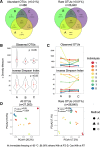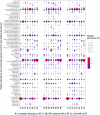Assessment of the impact of different fecal storage protocols on the microbiota diversity and composition: a pilot study
- PMID: 31253096
- PMCID: PMC6599303
- DOI: 10.1186/s12866-019-1519-2
Assessment of the impact of different fecal storage protocols on the microbiota diversity and composition: a pilot study
Abstract
Background: Fecal samples are currently the most commonly studied proxy for gut microbiota. The gold standard of sample handling and storage for microbiota analysis is maintaining the cold chain during sample transfer and immediate storage at - 80 °C. Gut microbiota studies in large-scale, population-based cohorts require a feasible sample collection protocol. We compared the effect of three different storage methods and mock shipment: immediate freezing at - 80 °C, in 95% ethanol stored at room temperature (RT) for 48 h, and on blood collection card stored at RT for 48 h, on the measured composition of fecal microbiota of eight healthy, female volunteers by sequencing the V4 region of the 16S rRNA gene on an Illumina MiSeq.
Results: Shared operational taxonomic units (OTUs) between different methods were 68 and 3% for OTUs > 0.01 and < 0.01% mean relative abundance within each group, respectively. α and β-diversity measures were not significantly impacted by different storage methods. With the exception of Actinobacteria, fecal microbiota profiles at the phylum level were not significantly affected by the storage method. Actinobacteria was significantly higher in samples collected on card compared to immediate freezing (1.6 ± 1.1% vs. 0.4 ± 0.2%, p = 0.005) mainly driven by expansion of Actinobacteria relative abundance in fecal samples stored on card in two individuals. There was no statistically significant difference at lower taxonomic levels tested.
Conclusion: Consistent results of the microbiota composition and structure for different storage methods were observed. Fecal collection on card could be a suitable alternative to immediate freezing for fecal microbiota analysis using 16S rRNA gene amplicon sequencing.
Keywords: Card; Cohort study; Fecal storage; Gut microbiota; Mock shipment.
Conflict of interest statement
The authors declare that they have no competing interests.
Figures



Similar articles
-
Effects of Stool Sample Preservation Methods on Gut Microbiota Biodiversity: New Original Data and Systematic Review with Meta-Analysis.Microbiol Spectr. 2023 Jun 15;11(3):e0429722. doi: 10.1128/spectrum.04297-22. Epub 2023 Apr 24. Microbiol Spectr. 2023. PMID: 37093040 Free PMC article.
-
Collection of non-meconium stool on fecal occult blood cards is an effective method for fecal microbiota studies in infants.Microbiome. 2017 Sep 5;5(1):114. doi: 10.1186/s40168-017-0333-z. Microbiome. 2017. PMID: 28870234 Free PMC article.
-
Interpersonal Variations in Gut Microbiota Profiles Supersedes the Effects of Differing Fecal Storage Conditions.Sci Rep. 2018 Nov 26;8(1):17367. doi: 10.1038/s41598-018-35843-0. Sci Rep. 2018. PMID: 30478355 Free PMC article.
-
Reliability of a participant-friendly fecal collection method for microbiome analyses: a step towards large sample size investigation.BMC Microbiol. 2018 Sep 6;18(1):110. doi: 10.1186/s12866-018-1249-x. BMC Microbiol. 2018. PMID: 30189859 Free PMC article.
-
From-Toilet-to-Freezer: A Review on Requirements for an Automatic Protocol to Collect and Store Human Fecal Samples for Research Purposes.Biomedicines. 2023 Sep 28;11(10):2658. doi: 10.3390/biomedicines11102658. Biomedicines. 2023. PMID: 37893032 Free PMC article. Review.
Cited by
-
Comparison of DNA extraction methods for 16S rRNA gene sequencing in the analysis of the human gut microbiome.Sci Rep. 2023 Jun 24;13(1):10279. doi: 10.1038/s41598-023-33959-6. Sci Rep. 2023. PMID: 37355726 Free PMC article.
-
Effects of Stool Sample Preservation Methods on Gut Microbiota Biodiversity: New Original Data and Systematic Review with Meta-Analysis.Microbiol Spectr. 2023 Jun 15;11(3):e0429722. doi: 10.1128/spectrum.04297-22. Epub 2023 Apr 24. Microbiol Spectr. 2023. PMID: 37093040 Free PMC article.
-
The maintenance of microbial community in human fecal samples by a cost effective preservation buffer.Sci Rep. 2021 Jun 29;11(1):13453. doi: 10.1038/s41598-021-92869-7. Sci Rep. 2021. PMID: 34188136 Free PMC article.
-
Non-significant influence between aerobic and anaerobic sample transport materials on gut (fecal) microbiota in healthy and fat-metabolic disorder Thai adults.PeerJ. 2024 Apr 19;12:e17270. doi: 10.7717/peerj.17270. eCollection 2024. PeerJ. 2024. PMID: 38650647 Free PMC article.
-
Azithromycin Exposure Induces Transient Microbial Composition Shifts and Decreases the Airway Microbiota Resilience from Outdoor PM2.5 Stress in Healthy Adults: a Randomized, Double-Blind, Placebo-Controlled Trial.Microbiol Spectr. 2023 Jun 15;11(3):e0206622. doi: 10.1128/spectrum.02066-22. Epub 2023 Apr 24. Microbiol Spectr. 2023. PMID: 37093053 Free PMC article. Clinical Trial.
References
-
- Zeevi D, Korem T, Zmora N, Israeli D, Rothschild D, Weinberger A, Ben-Yacov O, Lador D, Avnit-Sagi T, Lotan-Pompan M, et al. Personalized nutrition by prediction of glycemic responses. Cell. 2015;163(5):1079–1094. - PubMed
-
- Backhed F, Fraser CM, Ringel Y, Sanders ME, Sartor RB, Sherman PM, Versalovic J, Young V, Finlay BB. Defining a healthy human gut microbiome: current concepts, future directions, and clinical applications. Cell Host Microbe. 2012;12(5):611–622. - PubMed
Publication types
MeSH terms
Substances
LinkOut - more resources
Full Text Sources
Medical

